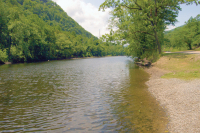Timber harvest at Devil’s Courthouse a good idea
To the Editor:
Nature abhors a vacuum. Mother Nature assures change. Organisms are constantly adapting, changing, improving, evolving. Understand-ing life cycles in nature assists man in many ways. We can collect water, grow vegetables, clear land, harvest timber, fish for food, hunt the wildlife and even recreate on our wild lands.
Whatever “our” case may be, nature is constantly in motion, changing. Stop mowing your lawn and watch a small forest begin: berries, scrubby pines, locust trees, and soon, poplar trees. The forest grows on over a span of time. Our southern Appalachian mountain region naturally grows incredible hardwood trees of many varieties: red oak, white oak, chestnut, oak, hickory, tulip poplar, walnut, cherry, maples, ash, birch, basswood and so on.
We are so blessed to live in this region of deciduous beauty. Our forest resources have tremendous beauty, but they also provide us with much bounty, and that must be respected, understood and included in forest management plans.
All living things die. In death, there is life. We know that all living things have a life cycle, and then they will die. Managing forests requires many different approaches to handling varying ages of forest sections. The United States Forest Service is charged with managing our federal lands for multiple uses: timber, water, wildlife and recreation. Each of these objectives is carefully weighed and included in plans for our forestlands.
Man can mimic natural death by timing timber harvest carefully and with full intention for each treatment area. The resource professionals allow science to direct their action, and timber management should be included in the tool belt of prescriptions, along with forest thinnings, prescribed fire, use of herbicides to eradicate invasive species and so on ... all options should be left on the table.
To preserve something is to save it. A passive land management approach allows nature to take hold as it will. Man has a minimal impact on the environment and takes a hands-off attitude. To preserve the land is to lock it up and leave it.
A museum mentality has taken over our national forest policy: “you can look, but not touch.” I think man should wisely use and respect our renewable resources and be encouraged to keep these large land tracts in timber rotations, rather than converting them out of a forest-use, rarely to grow trees again once paved.
Conserving the resource allows us to use the bounty, sustainably, and with an eye for the next generation, leaving the land more productive and better than before.
Disturbance happens. Ice, wind, fire, tornados, flooding, hurricanes, typhoons, and hail are a few natural events that wreak havoc for man on earth. Disturbances will always occur. The early Native Americans would slash and burn forests, to manage the land for their lifestyle and kept the understory growth down with prescribed fires to encourage wildlife proliferation. Man has always worked to tame the land. Modern-day timber harvest can mimic these natural disturbances, while growing jobs, creating American-made products, and providing year-round revenue for our local economies, sustainably and perpetually. Waste not, want not.
Wood is good. Trees are the gifts that keep giving. During their growing life, they provide shade, fruits and foods for man and creature alike, and provide immense beauty to our mountains. With a common-sense and pragmatic approach to land management, trees can be harvested to enjoy a whole new life of giving: in the form of a handmade generational piece of fine furniture to be coveted and passed down within a family line. Perhaps the trees will be used to fashion hardwood floors in a home to also last another lifetime. Wood is good, renewable, and can be managed in perpetuity. Please do not lock up these resources, because to watch them grow and die without using and enjoying them is a true waste of their many gifts.
We need wood. With carefully planned timber harvests, brand-new money is created by taking a raw material and converting it into lumber. From there it grows into heirloom furniture, fine homes, hardwood flooring, and so on. The “leftovers” from sawdust, mulch, and chips make all sorts of items we need: juice containers, envelopes, cardboard, pressed board items, paper products etc. The “resins” go into hairspray, glues, steering wheels, spray paints and crayons. Even aspirin and ice cream contain wood products! We need wood, and trees can infinitely provide us with value-added products using carefully planned management approaches.
Please allow the United States Forest Service to move forward with the project at Devil’s Courthouse. Please do not impede our natural resource professionals from actively managing our forestlands, now or in the future.
Susan Fletcher
Candler





